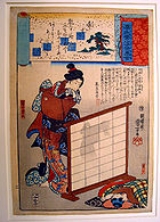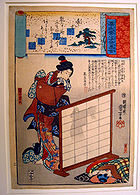
Kuzunoha
Encyclopedia

Kitsune
is the Japanese word for fox. Foxes are a common subject of Japanese folklore; in English, kitsune refers to them in this context. Stories depict them as intelligent beings and as possessing magical abilities that increase with their age and wisdom. Foremost among these is the ability to assume...
character in Japanese folklore
Japanese folklore
The folklore of Japan is heavily influenced by both Shinto and Buddhism, the two primary religions in the country. It often involves humorous or bizarre characters and situations and also includes an assortment of supernatural beings, such as bodhisattva, kami , yōkai , yūrei ,...
. Her name means kudzu
Kudzu
Kudzu is a plant in the genus Pueraria in the pea family Fabaceae, subfamily Faboideae. It is a climbing, coiling, and trailing vine native to southern Japan and southeast China. Its name comes from the Japanese name for the plant, . It is a weed that climbs over trees or shrubs and grows so...
leaf. Legend states that she is the mother of Abe no Seimei
Abe no Seimei
was an onmyōji, a leading specialist of onmyōdō during the middle of the Heian Period in Japan. In addition to his prominence in history, he is a legendary figure in Japanese folklore and has been portrayed in a number of stories and films....
, the famous onmyōji.
Legend

Jinja (Shinto)
A Shinto shrine is a structure whose main purpose is to house one or more Shinto kami....
in Shinoda, in Settsu Province
Settsu Province
was a province of Japan, which today comprises the eastern part of Hyōgo Prefecture and the northern part of Osaka Prefecture. It was also referred to as or .Osaka and Osaka Castle were the main center of the province.-History:...
, encounters a young military commissioner who is hunting foxes in order to obtain their livers for use as medicine
Medicine
Medicine is the science and art of healing. It encompasses a variety of health care practices evolved to maintain and restore health by the prevention and treatment of illness....
. Yasuna battles the hunter, sustaining several wounds in the process, and sets free the white fox he had trapped. Afterward, a beautiful woman named Kuzunoha comes along and helps him return to his home.
In reality, this woman is the fox he had saved, adopting human form in order to tend to his wounds. He falls in love with her, and they marry. Later, she bears him a child, Seimei
Abe no Seimei
was an onmyōji, a leading specialist of onmyōdō during the middle of the Heian Period in Japan. In addition to his prominence in history, he is a legendary figure in Japanese folklore and has been portrayed in a number of stories and films....
(childhood name Dōji), who proves prodigiously clever. Kuzunoha realizes that her son has inherited part of her supernatural nature.
Several years later, while Kuzunoha is viewing some chrysanthemum
Chrysanthemum
Chrysanthemums, often called mums or chrysanths, are of the genus constituting approximately 30 species of perennial flowering plants in the family Asteraceae which is native to Asia and northeastern Europe.-Etymology:...
s, her son catches sight of the tip of her tail. Her true nature revealed, Kuzunoha prepares to depart to return to her life in the wild. She leaves behind a farewell poem
Poetry
Poetry is a form of literary art in which language is used for its aesthetic and evocative qualities in addition to, or in lieu of, its apparent meaning...
, asking her husband Yasuna to come to see her in Shinoda forest.
Yasuna and his son search Shinoda for Kuzunoha, and eventually she appears to them as a fox. Revealing that she is the kami
Kami
is the Japanese word for the spirits, natural forces, or essence in the Shinto faith. Although the word is sometimes translated as "god" or "deity", some Shinto scholars argue that such a translation can cause a misunderstanding of the term...
, or deific spirit, of Shinoda shrine, she gives her son Seimei a gift, allowing him to comprehend the language of beasts.
Plays
Kuzunoha figures in kabukiKabuki
is classical Japanese dance-drama. Kabuki theatre is known for the stylization of its drama and for the elaborate make-up worn by some of its performers.The individual kanji characters, from left to right, mean sing , dance , and skill...
and bunraku
Bunraku
, also known as Ningyō jōruri , is a form of traditional Japanese puppet theater, founded in Osaka in 1684.Three kinds of performers take part in a bunraku performance:* Ningyōtsukai or Ningyōzukai—puppeteers* Tayū—the chanters* Shamisen players...
plays based on her legend, including the five-part Ashiya Dōman Ōuchi Kagami (A Courtly Mirror of Ashiya Dōman). The fourth part, Kuzunoha or The Fox of Shinoda, which is frequently performed independently of the other scenes, focuses on her story, adding minor variations such as the idea that Kuzunoha imitates a princess and is forced to depart not because Seimei glimpsed her tail but because the real woman unexpectedly appears.
In Izumi
In IzumiIzumi, Osaka
is a city located in Osaka, Japan.The city was founded on September 1, 1956.As of 2010, the city has an estimated population of 181,935 and the density of 2,140 persons per km². The total area is 84.98 km². It is the last station on the Semboku Kousoku monorail line (泉北高速鉄道) at Izumi Chuo...
there is a Kuzunoha Inari
Inari (mythology)
is the Japanese kami of fertility, rice, agriculture, foxes, industry and worldly success and one of the principal kami of Shinto. Represented as male, female, or androgynous, Inari is sometimes seen as a collective of three or five individual kami...
shrine, said to be built upon the place at which Kuzunoha departed, leaving her farewell poem on a silk screen.
The poem itself has become famous: "Koishiku ba / tazunekite miyo / izumi naru / shinoda no mori no / urami kuzunoha." Folklorist Kiyoshi Nozaki offers the following translation: "If you love me, darling, come and see me. / You will find me yonder in the great wood / Of Shinoda of Izumi Province where the leaves / Of arrowroots always rustle in pensive mood."
A pond in the area is also remembered in connection with the legend, and has been designated a historic site by the city.

